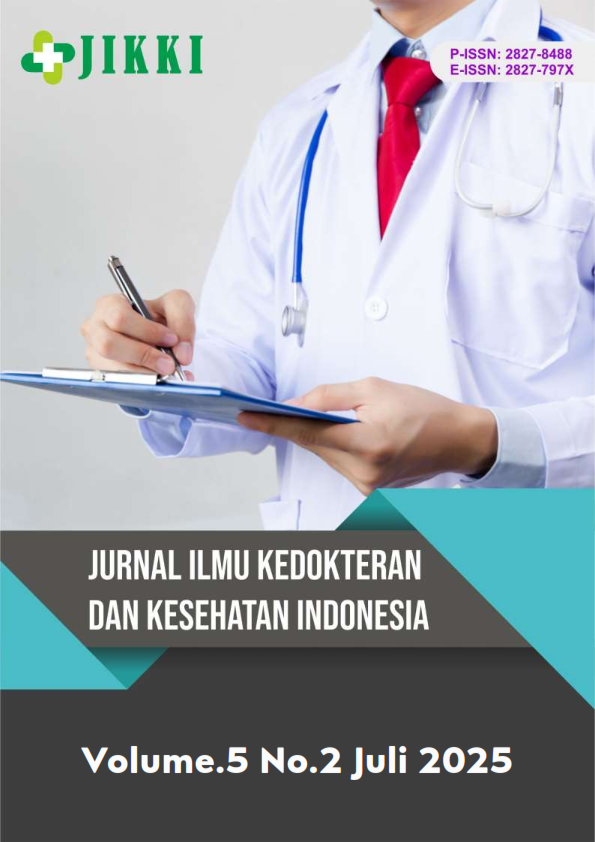Hubungan Antara Kualitas Tidur dengan Kelelahan Kerja pada Pekerja Penyapu Jalan di Kota Manado
DOI:
https://doi.org/10.55606/jikki.v5i2.6717Keywords:
Sleep Quality, Street Sweeper, Work Fatigue, Sleep Quality, Street Sweeper, Work FatigueAbstract
Work fatigue can result in many things, namely decreased workload, decreased physiological and nervous function, poor feelings and health, and decreased morale (Allo and Yanti, 2022). The International Labor Organization (ILO) states that almost every year two million workers die from work accidents caused by fatigue factors. Low quality and quantity of sleep (for example working at normal sleep times) or due to excessive physical and mental activity in the workplace are common causes of work fatigue (Haritsah, 2023). The purpose of this study was to analyze the relationship between sleep quality and work fatigue in street sweepers in Manado City.The study used a quantitative method with a cross-sectional study design, conducted in Sario, Malalayang, and Wanea Districts, Manado City with a population of 56 workers and a sample of 52 samples selected using the purposive sampling method. The research instruments used were the Pittsburgh Sleep Quality Index (PSQI) and the Subjective Self Rating Test from IFRC. Data were analyzed univariately and bivariately using the Spearman Rank correlation test.The results of the study found that most street sweepers in Manado City have poor sleep quality (71.2%) compared to those with good sleep quality (28.8%) while work fatigue at the moderate work fatigue level (50%) followed by low work fatigue levels (25%) and high work fatigue levels (25%). The results of the study between sleep quality and work fatigue obtained a p-value = 0.000 which means there is a relationship and the correlation coefficient value (r) = 0.78 which shows a positive and strong unidirectional relationship where the worse the sleep quality, the higher the level of work fatigue.
References
Allo, A. A., & Yanti, P. (2022). Hubungan beban kerja fisik, kualitas tidur terhadap kelelahan kerja pengemudi bentor di Kelurahan Mentirotiku, Toraja Utara. Jurnal Kesehatan dan Kedokteran, 1(3), 46–51. https://doi.org/10.56127/jukeke.v1i3.308
Andiani, I. P., Kawatu, P. A., & Ratag, B. T. (2019). Hubungan antara beban kerja dan asupan kalori dengan kelelahan kerja pada tenaga kerja bongkar muat di Pelabuhan Samudera Bitung. Jurnal Kesehatan Masyarakat, 7(4), 1–8.
Armadani, D. F., & Paskarini, I. (2023). Systematic review: Analisis hubungan kualitas tidur dengan kelelahan kerja pada tenaga kerja. Jurnal Penelitian Perawat Profesional, 5, 1113–1122.
Ferrada, X., Barrios, S., Masalan, P., & Campos-Romero, S. (2021). Sleep duration and fatigue in construction workers: A preliminary study. Open Theory in Management and Construction Journal, 2021(3), 2496–2504. https://doi.org/10.2478/otmcj-2021-0029
Gutiérrez, J. L., González, J., Moreno, B., Hernández, R. E., & López, A. (2005). Spanish version of the Swedish Occupational Fatigue Inventory (SOFI): Factorial replication, reliability and validity. International Journal of Industrial Ergonomics, 35, 737–746.
Haritsah, F. I. (2023). Kelelahan kerja dan cara mengatasinya. Direktorat Jenderal Kesehatan Lanjutan – Kementerian Kesehatan Republik Indonesia. https://yankes.kemkes.go.id/view_artikel/2027/kelelahan-kerja-dan-cara-mengatasinya#
Imbara, S. F., Badriah, D. L., Iswarawanti, D. N., & Mamlukah, M. (2023). Faktor-faktor yang berhubungan dengan kelelahan kerja pada operator dump truck mining dept saat shift malam di PT. X Cirebon 2023. Journal of Health Research Science, 3(2), 175–188. https://doi.org/10.34305/jhrs.v3i02.940
Kurniawan, I., & Sirait, G. (2021). Analisis kelelahan kerja di PT. ABC. Jurnal Comasie, 4, 5.
Pabumbun, E. N., Russeng, S. S., & Muis, M. (2022). Faktor yang berhubungan dengan kelelahan kerja pada pekerja PT. Maruki International Indonesia. Hasanuddin Journal of Public Health, 3(1), 90–98. https://doi.org/10.30597/hjph.v3i1.21595
Pratama, M. A., & Wijaya, O. (2019). Hubungan antara shift kerja, waktu kerja dan kualitas tidur dengan kelelahan pada pekerja PT. Pamapersada Sumatera Selatan. Journal of Chemical Information and Modeling, 47, 1–10.
Prodia. (2024). Kelelahan kerja. PT. Prodia Occupational Health Indonesia. https://prodiaohi.co.id/kelelahan-kerja
Rachmawati, S., & Pravika, U. H. (2020). Analisis pemenuhan kebutuhan kalori berdasarkan jenis pekerjaan pada tenaga kerja di area tambang bawah tanah PT X Indonesia. Journal of Industrial Hygiene and Occupational Health, 4(2). https://doi.org/10.21111/jihoh.v4i2.3830
Sugiono, S., & Wijayanto Putro, W. (2021). Ergonomi untuk pemula: Prinsip dasar & aplikasinya. (Tanpa penerbit).
Sulfikar, Batara, S., & Amelia, A. R. (2024). Pengaruh status gizi terhadap kelelahan kerja pada karyawan bagian rotary 9 feet. Window of Public Health Journal, 5(1), 109–116. https://doi.org/10.33096/woph.v5i1.540
Sumardiyono, Chafiidhiya Rochmah, S., & Seviana Rinawati. (2023). Faktor-faktor yang berhubungan dengan kelelahan kerja pada pekerja penyapu jalan di Kota Surakarta. Journal of Applied Agriculture, Health, and Technology, 2(1), 34–42. https://doi.org/10.20961/jaht.v2i1.594
Supit, M. I. A. L., Kawatu, P. A. T., & Kalesaran, A. F. C. (2021). Hubungan antara stres kerja dengan kelelahan kerja pada petugas LLAJ Dinas Perhubungan Kota Manado. Jurnal Kesmas, 10(3), 95–104.
Downloads
Published
How to Cite
Issue
Section
License
Copyright (c) 2025 Jurnal Ilmu Kedokteran dan Kesehatan Indonesia

This work is licensed under a Creative Commons Attribution-ShareAlike 4.0 International License.








